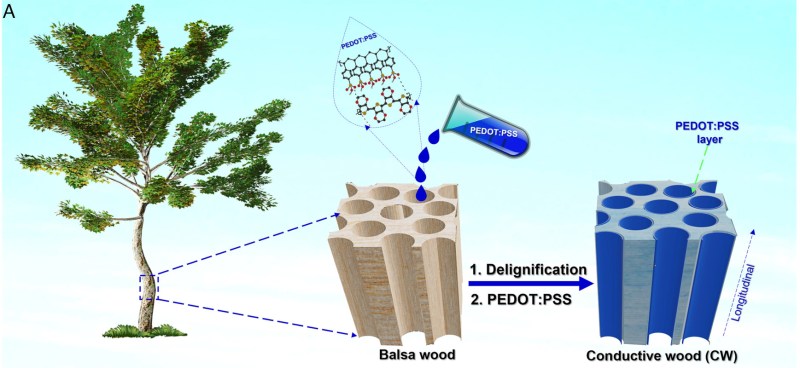Modern technology is riddled with innovations that were initially inspired by the natural world. Velcro, bullet trains, airplanes, solar panels, and many other technologies took inspiration from nature to become what they are today. While some of these examples might seem like obvious places to look, scientists are peering into more unconventional locations for this transistor design which is both inspired by and made out of wood.
The first obvious hurdle to overcome with any electronics made out of wood is that wood isn’t particularly conductive, but then again a block of silicon needs some work before it reliably conducts electricity too. First, the lignin is removed from the wood by dissolving it in acetate, leaving behind mostly the cellulose structure. Then a conductive polymer is added to create a lattice structure of sorts using the wood cellulose as the structure. Within this structure, transistors can be constructed that function mostly the same as a conventional transistor might.
It might seem counterintuitive to use wood to build electronics like transistors, but this method might offer a number of advantages including sustainability, lower cost, recyclability, and physical flexibility. Wood can be worked in a number of ways once the lignin is removed, most notably when making paper, but removing the lignin can also make the wood relatively transparent as well which has a number of other potential uses.
Thanks to [Adrian] for the tip!
















Now we just need transparent aluminium.
Transparent Aluminum already exists. It is called Sapphire.
We do. It was patented 6 years before Star Trek IV too.
AI can help with that… “Hello computer….”
They have already done that. They have observed Aluminum go ito a brief transparent state when hit by massive amounts of X-Rays. Kids, don’t try this at home.
A whole-house solar panel.
Light emitting wood diodes
Instead of a foundry, they’ll be made in a chipper.
aka LEWDs
I’ll see myself out…
Hmmmmm…. Maybe LED light bulbs could be made cheaper? How about 3D printing RGB diodes on plywood. Wow 4′ X 8′ displays.
acetate? you obviously don’t know what acetate is…did you even read the paper? its an “acetate BUFFER” which is just a fancy way of saying the reaction took place at low pH. the delignification works with a standard sodium chlorite solution like 80% of all the methodes out there. calling this material wood is very generous at best it would be more accurate to call it a cellulose matrix. also don’t get the big whoop so yeah they found yet another way to functionalize wood and make it conductive nothing that has not been done before.
You aren’t as smart as you seem to think you are. Lighten up.
No actually, I think we need these kind of people in the discourse. Thank you Snow
Organic electrochemical transistors are a thing, but what makes this way of making them better in any way, rather than simply novel?
All the articles about this just say “it might have uses” without really delving into that. I’m completely confused as to what uses of any sort thing might possibly have. It’s bigger, slower, weaker, more degradable, etc etc compared to silicon chips. At first I thought maybe its uses might lie in biodegradable applications, but reading more carefully I realize the PEDOT polymer is the actual transistor with the wood mostly just acting to hold it in place. I could see a completely biodegradable transistor maybe having uses in things like, say, medical applications, though it’s too slow as it stands right now — except this isn’t actually properly biodegradable anyway… So it the actual device will break down and stop working correctly over time because of the wood, but the actual PEDOT polymer will probably break down far far slower in comparison, thus making it unsuited even for biodegradable applications… It doesn’t even remove reliance on silicon since PEDOT polymers do heavily utilize silicon too. (Though it must surely use a lot less than silicon wafers in chips.)
Actually, this seems more like it’s completely aimed in the wrong direction. The PEDOT is the real star of the show here from the look of things. While wood transistors don’t sound very helpful, it might perhaps be adaptable to things like flexible applications for example. Perhaps even a lot of other things. I suppose if this experiment has any true use it’s probably merely in delving into ways of using the PEDOT polymers to learn more about their capabilities.
“All the articles about this just say “it might have uses”
So the story goes that after he saw a hot air balloon for the first time; Ben Franklin was asked “What good is it?” And he replied “What good is a baby?”